Natural Homemade Dish Soap That Works
This natural homemade dish soap recipe is so easy to make, smells wonderful, works amazingly well, saves you money, and is environmentally friendly. How much better can it get? Not only will it cut through grease, but it’s safe for you and your family.
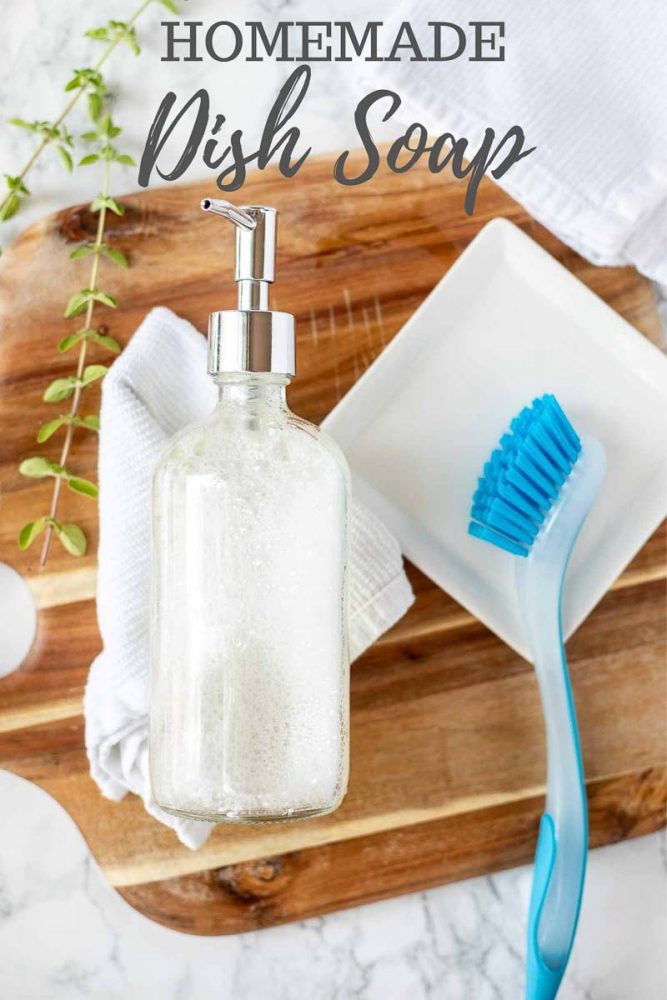
This natural dish soap is a new twist on a very old recipe on the blog.
I did some tweaking to fix some problems that were coming up, and the new results are so much better! No more grating a bar soap with inconsistent results.
So many people find that homemade cleaners don’t work as well as their chemical counterparts, but I can assure you that this one works well.
It’s tough on grease and suds up amazingly well, making it easy to enjoy this natural switch.
It is also cheaper than typical, natural dish soaps, which usually cost around $4 per 25 oz. This one will set you back around $3. So, slightly cheaper.
It also has a better rating from the EWG website. I’ve tried a few of the store-bought, natural dish soap options, and I find them to be disappointing, and you need a lot of it for it to work.
However, I still love to use the store-bought options in this really effective DIY Stain Remover.
We’ve loved this natural DIY dish soap recipe in our house. Getting used to the consistency takes a little adjustment, and you don’t have to use very much for great results.
I promise you, this recipe works great, and your dirty dishes will become remarkably clean.
Why you will love this recipe:
Actually works: Greasy dishes stand no chance with this homemade version.
Natural ingredients: Commercial dish soap contains many harmful ingredients that are known endocrine disruptors like fragrance. When it comes to finding a natural store-bought dish soap, I like to check the EWG (environmental working group) website to see the healthiest options. Transitioning to natural cleaning products is a great way to reduce your exposure to harmful chemicals and create a healthier home environment.
Easy: The good news is making your own homemade dish soap is way easier than you think. Using a liquid soap like sal suds, makes this process much easier. No grating, boiling down ingredients, mixing for long periods or using special equipment (like an immersion blender).
Eco-friendly: Not only will you reduce your environmental impact by cutting down on plastic packaging, but also contribute to a more eco-friendly cleaning routine for a healthier planet and home.
Customizable: Making your own dish soap also allows you to customize the scent and strength of the soap to suit your preferences and cleaning needs.
Cost effective: More cost-effective option in the long run, as many of the ingredients needed are often pantry staples or easily accessible at local stores.
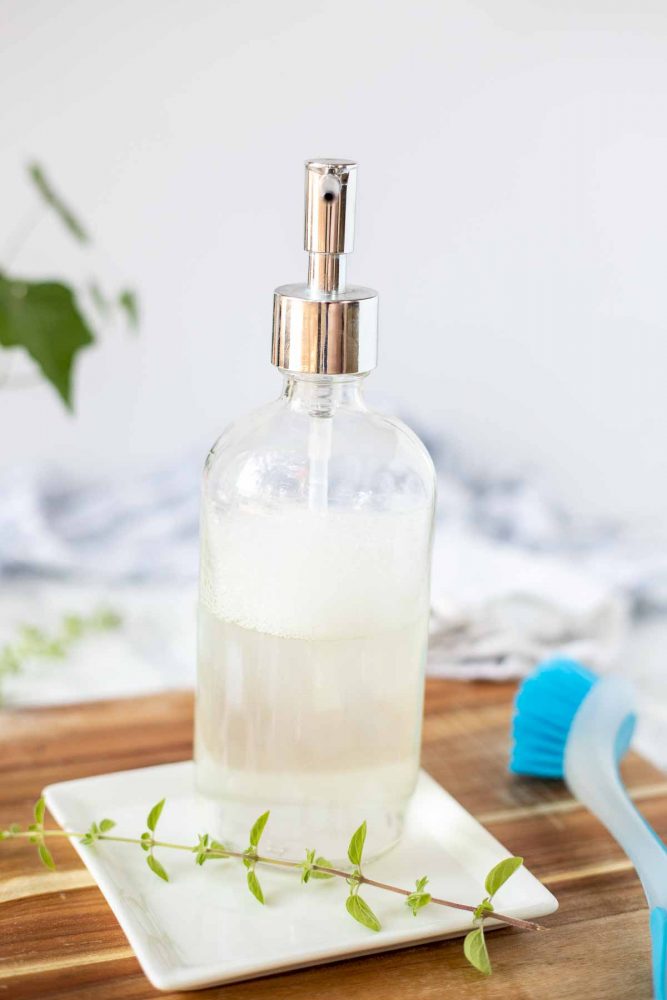
Tips:
- The consistency is much thinner than regular dish soap, and a little bit goes a long way. Just because it is runny doesn’t mean it is ineffective.
- You can place it in a soap pump, foaming soap pump, or just put it in an old, dish soap bottle.
- You may have to shake it up a little before you use it, but it shouldn’t clump and separate like the last recipe!
- Don’t substitute the sal suds for liquid castile soap. Since this recipe contains vinegar, it will not work with castile soap.
The following are affiliate links. We are a participant in the Amazon Services LLC Associates Program and other affiliate programs that are designed to provide a means for us to earn fees by linking to Amazon.com and affiliated sites.
Tools you may need:
Measuring spoons
Spoon
Soap dispenser. A foaming pump dispenser works the best. I like to use a glass rather than plastic bottles when using essential oils, because oils can break down the plastic.
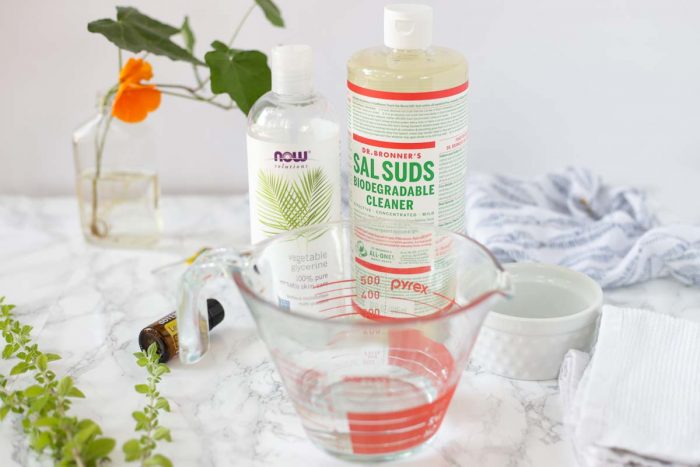
The Ingredients:
- Dr. Bronner Sal Suds – This is like the ultra-concentrated, cleaning power of Castile soaps (which is a staple in any natural-living cabinet, hello, hand soap). This mild detergent is powerful and works amazingly well to clean dishes without any soap scum or residue. It can also be used to clean floors, counters, laundry, and more. It also works great in hard water (something we struggle with here at our house).
- Some people don’t like the fact that it contains sodium lauryl sulfate, and believe it to be carcinogenic. According to the company, it is a processed ingredient made from coconut that studies find have no carcinogenic effects (source).
- This is also different from castile soap, which doesn’t work very well for cleaning (and can’t be used in conjunction with vinegar, which this recipe contains). Castile soap is a soap that is meant to be used for personal care and better for your skin, while sal suds is a mild detergent.
- Water – I would recommend using distilled water or water that was boiled and cooled to help reduce the chance of bacterial growth.
- Vinegar – Helps cut grease and provides a streak-free shine.
- Vegetable glycerin (optional) – This helps create more sudsing power and helps moisturize your hands.
- Your favorite essential oils (optional): Twenty drops of your favorite essential oils. Ones used specifically for cleaning are my favorite. This is citrus oils, pine, tea tree, spruce essential oil, etc.
Essential Oils
Essential oils not only add a pleasant scent to your dish soap, but also offer additional cleaning and antibacterial properties.
Lemon essential oil or citrus essential oil. One of my favorites to add since citrus oils work great as a degreaser to get those dishes squeaky clean.
Other essential oils have antibacterial properties. Optional: 10-20 drops of On-Guard, Thieves, or tea tree oil (anti-bacterial; if you like the smell you can add more, if not, add less). You can really play around with different essential oils to find your favorite.
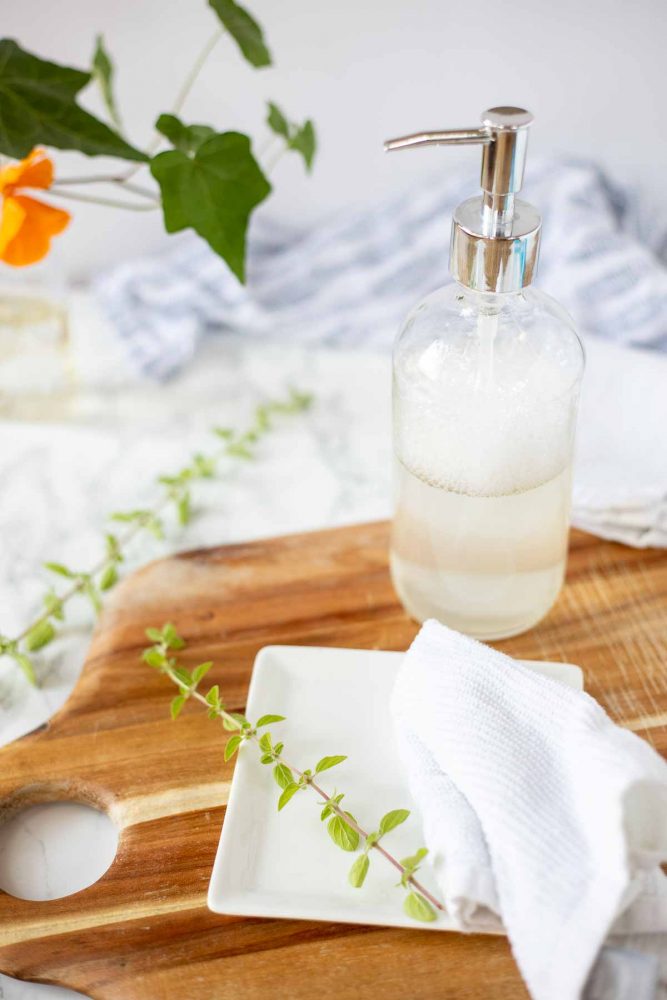
How To Make Natural Homemade Dish Soap:
If not using distilled water, bring water to a boil for a few minutes and then let it cool down a bit before starting the next step.
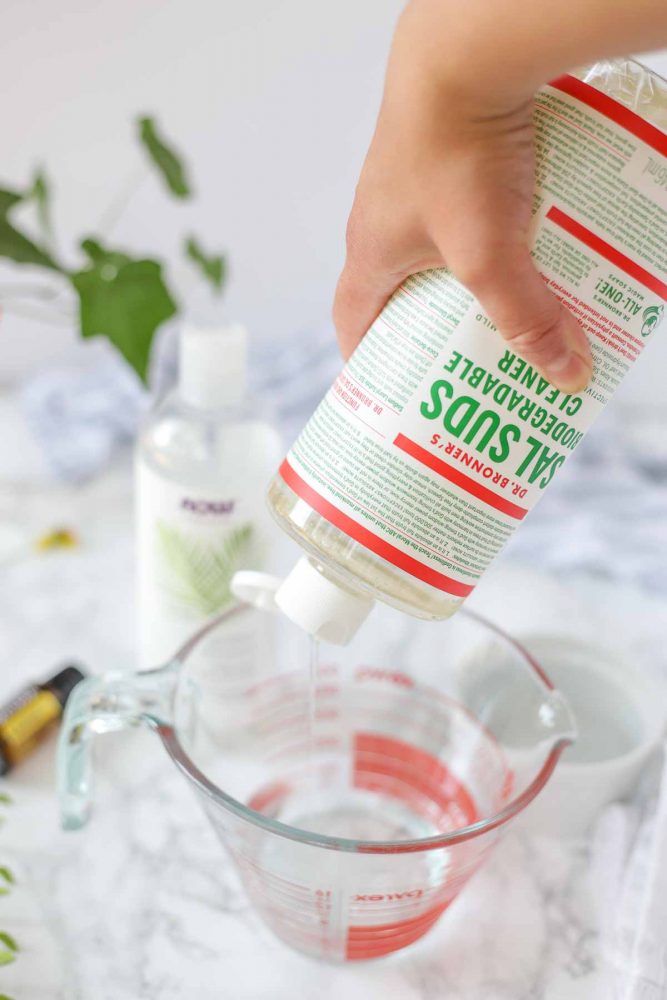
n a medium-sized bowl, combine all of the ingredients and stir well.

Add 20 drops of essential oil. I like to use citrus oils, like lemon, because it is tough on grease. You can also use anti-bacterial type oils like On-Guard or Thieves. Tea tree would also work well.
Pour homemade soap into a foaming soap dispenser. You can also use mason jars or another container, but a foaming dispenser is what I found to work the best.
That’s it! Wasn’t that easy? You do like two minutes of work and you’re done.
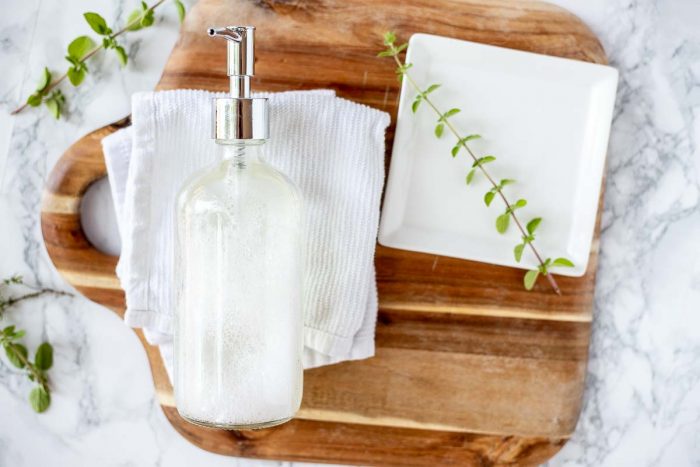
Variations:
Citrus: Add 20 drops of lemon, grapefruit, mandarin, etc.
Lavender mint: One of my favorite combos adds about 15 drops of lavender and 5 drops of peppermint.
Holiday: I love Christmas tree smells with pine, Siberian fir, Douglas fir, etc. Or that classic holiday smells of clove, cinnamon, orange, and Douglas fir.
Herbal mint: Add mint (or spearmint) and eucalyptus.
Tips For Using This DIY Dish Soap
- Be sure to shake the bottle before each use to ensure the ingredients are well mixed.
- When washing dishes, use a small amount of soap as a little goes a long way with these concentrated formulas.
- For tough grease or baked-on food, allow the soap to sit on the dishes for a few minutes before scrubbing.
- Additionally, consider using a natural bristle brush or sponge to help with scrubbing power without scratching delicate dishes. After washing, be sure to rinse thoroughly to remove any soap residue (luckily sal suds are very biodegradable and have been approved for gray water systems).
FAQ
You can in a pinch, but I would recommend this foaming hand soap to use instead because it is much more gentle on your hands.
Or this natural hand sanitizer while you’re out and about.
Vinegar alone can not replace dish soap because it does not break down fats like soap will.
Hand soaps usually contain other ingredients that will leave residue on your dishes like skin softeners and fragrances. They will not rinse off leaving a bad taste in your mouth.
Yes you can, but I found it not a super effective dish detergent. Dishes would still have grease or residue left after using it. Sal suds is a much more effective cleaner for dishes.
Would I be in a pinch if I had nothing else? Yes I would.
Find More Homemade Cleaning Products That Work!
- All-Purpose Cleaner (that can also be used on glass!)
- DIY Furniture Polish
- Homemade dishwasher detergent
- Glass-Cleaner
- Homemade Laundry Detergent
- 15 House Cleaning Tips For A Naturally Clean Home
If you’ve tried and loved this recipe, make sure to come back and give it 5 stars and tag me on Instagram @ablossominglife.

Homemade Dish Soap
Equipment
- Measuring cup and spoons
Ingredients
- 3/4 cup distilled water or water that was boiled and cooled
- 1/2 cup sals suds
- 2 tbs whtie vinegar
- 1 tbs vegetable glycerin
- 20 drops essential oils
Instructions
- If not using distilled water, boil water for a few minutes and then allow to cool.
- In a medium-sized bowl, combine all of the ingredients and stir well.
- Add essential oils and stir. I like to use citrus oils (like lemon) because it is tough on grease.


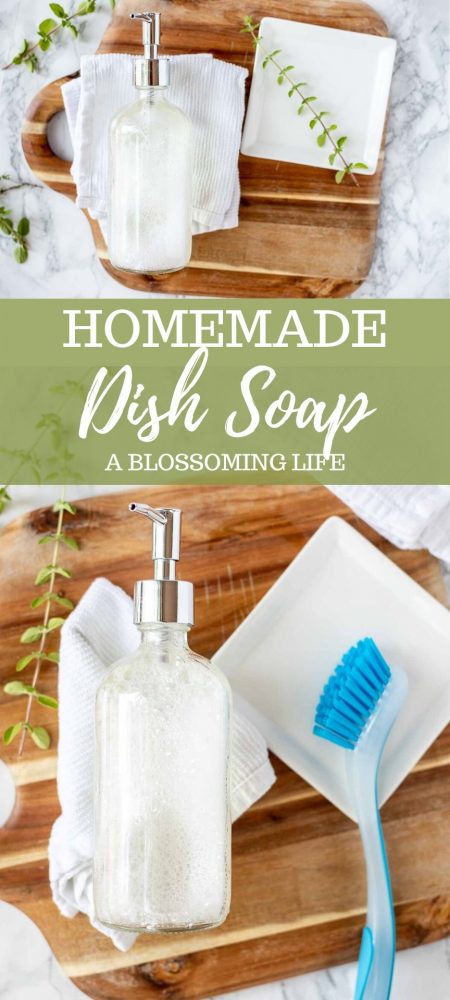
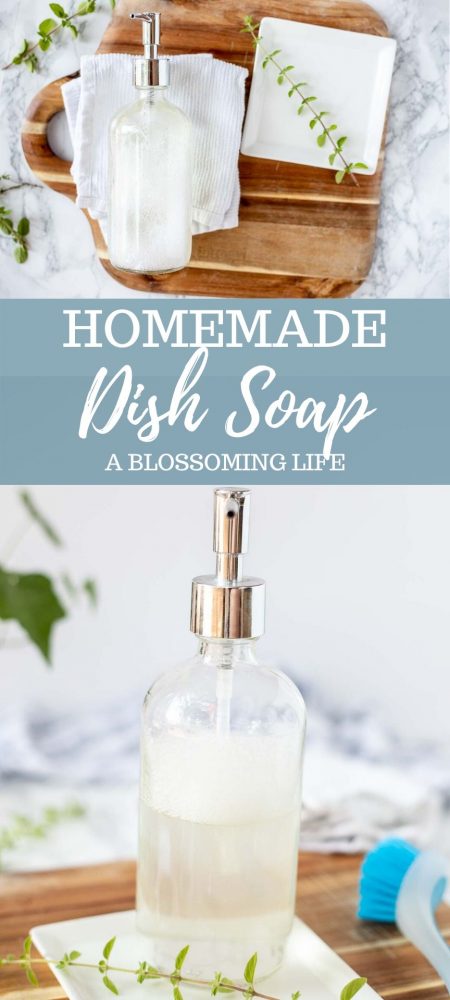
Well…Once I get rid of the glob I have now, I am going to try this. The ingredients are basically the same, but the process is different. I used a piece of Ivory soap I had left from some other thing I tried (I hate Ivory – it stinks). The other recipe used USP Glycerin (which I had and used)- I have no idea if the properties are different than vegetable glycerin (which I also have) BUT now I just have glop, and I have to use a ton. I have a little piece of the soap you have listed so hopefully by next week I can try this method.
thanks a lot for the recipe. I used Aleppo soap which is made from olive oil and Laurel oil. didn’t add tea oil nor glycerin cause don’t have them in hand. output was great and cleaning result was much better than using any of commercial detergents especially with egg residuals. one more point: I didn’t use gloves through the long time of dishwashing yesterday but my hands were not dry at all. Thank you again for the very simple recipe that it works Great 🙂
I made the new improved version of dish soap, but have a problem with it. It leaves a film on everything, especially myy brand new stainless steel cookware. My sink is also covered with a sticky film. Please let me know if anyone else has had this issue and how to correct it.
I think using towel to dry stainless cookware should help here. Cleaning the sink with the same soap ,after finish doing the dishes, should cut all stick grease.
Now, I don’t convert the hard soap to liquid. I just set the soap bar in small stainless bowl and add a cup of hot water. Then dip the sponge in the soapy water, add more hot water as needed, till finish doing the dishes.
Thank you for your responsed Fatima. However I did use a towel to dry everything, but there is some type of smearing film on them. I will try it again and see what I can do to prevent that. The build up in the sink is not a greasy buildup, but a white filmy, sticky buildup. I had to use regular dish soap to clean it off. I really want to make all my home products and am excited to learn more.
sorry for not being helpful., Though here is some points you may consider :
try another soap brand : I use Aleppo bar which is olive with laurel oil soap.
use vinegar in rinsing cycle ,instead of laundry softener liquid , when washing kitchen towels.
try another sponge brand
Thank you again. So, may I assume you don’t have this issue with the filmy coating? I do use vinegar for my softener in my wash. The only thing different is the soap. I used Dr. Bonner soap, which is suppose to be the best. But, perhaps I should try the one you suggested. When I put a sinkful of water with the dish soap in it, the white film floats on top of the water and coats everything it touches. It is so strange. All other home recipes I have tried have been so great. I will perhaps try another batch and see if I did something wrong. Thank you again for sharing your ideas with me.
you may consider omitting the glycerin from the recipe as long as you use gloves while dishing.
I may have figured out my issue…I read online that washing soda can be made by bsking some baking soda in the oven & tjat is what I used for both my dish soap & my dishwasher soap & neither of them are good…leaving a harsh film on everything. So I think I will try again with real washing soda. What do you think?
I use Dr Bonner’s also but I use the liquid (peppermint is too strong for my husband so he uses the lavender and I’m thinking of just getting the plain with no fragrance). I dilute it half and half with water but am thinking maybe 2/3 soap to 1/3 water but I’m probably thinking that because I’m so used to bubbles…..
I’m adjusting 🙂
I was wondering can I use other kinds of bar soap, like ivory or dove?? Or any other kind? I have tea tree oil and patchouli oil as well. Can I add some patchouli for smell I love the smell. Even if it was a few drops.
I made up a batch of Liquid dish soap and I now have a large glob of solid gel. What did do wrong? How to correct it? Used all the right products.
I made this recipe last month, and I have to say that it’s the best dish soap I’ve ever used! Although the lack of suds throws me off, it cleans like nothing and cuts grease beautifully! And it gets rid of any food/fishy smell that lingers on dishes!! Thanks for this recipe and the experiments you’ve done to improve it!!
Hi Amy! Thank you for the recipe. We added the tea tree oil and a little orange essential oil. It smells really, really good! We’re letting it set for 24 hours now. Excited to give it a try.
I have same question someone else asked but I didn’t see a reply. Since using essential oils which break down plastic, won’t it break down plasticky bowls & plates?
Since the essential oils are so diluted I wouldn’t think they would break down plastic bowls.
Since castile soap and acids will cancel each other, I wonder if a similar reaction may take place if adding essential oils like those of lemon or orange (the “citrus” kinds). Thanks!
Hello! So i was looking into using this recipe but I see that Dr. Bronners has Hemp oil and I am allergic to hemp (like hives allergic). DO you know of any Castile Bar soaps that do not have Hemp oil in them?
Hi, I have been using Kirk’s coco castile bar soap (fragrance free is better) for the different castile bar soap based recipes. I haven’t tried Dr Bronners soaps so I can’t compare the results, but as for me I think it works really well (worked for this recipe, works for the laundry soap recipe too and I have used it even on a shampoo recipe). As the name says, coco castile soap is based on coconuts, and is actually cheaper than Dr. Bronners. The only thing to have in mind is that since coconut soap and oils tend to solidify at colder temperatures, you must keep it in a warm place so it keeps its liquid consistency. I have found that in order to reduce this problem you must add the glycerine, maybe 1-2 tablespoons, and adding 1/2 tablespoon of almond oil (or grapeseed oil) seems to help in giving it better consistency. Feel free to contact me if you would like to know more about my experience with coco castile soap, through my site or email me [email protected], cheers 🙂
Thank you so much! I’ll have to try that!
Hello. Can orange peel be added ti this?
This is such a great recipe. I love DIY’s because you can make them green-friendly and organically. I’ve heard that adding a bit of coconut oil makes it so that it does not dry out your hands when you use it, what do you think about that!
Could you use the liquid version of that soap and skip the grating process.?
I’m so excited to try all these new DIY ideas and get the chemicals outta here! A couple of questions…do you use purified or distilled water? I’ve read several different places (almost on read-overload! lol) its a good idea to prevent mold…true or false? Its so easy to get confused…so many opinions and I’m swayed with each one :). I bought two bottles of Dr Bronners liquid castile because I have a recipe somewhere for shower soap….I haven’t had good luck with bars…I tried Zote bar soap with glycerine and purified water for hand soap…its thicker than jello…so I’m going to add even more water and see if that helps….the “string” that comes out won’t seperate or break…ewww! Is Zote soap an option, or is it only for laundry soap? I’ve made my own laundry soap and love it! Thanks for all your hard work, and then sharing! 🙂
I don’t know if this was covered or not. Be cautious with Tea Tree Oil around cats it is toxic.
I just made this and it s been about 6 hours, it’s still very liquid… Does it start to turn into liquid soap consistency soon? Or is that right?
Thanks for this! You have just given me a new idea on what to do with my home cleaning products. I’ll try the lemons zest next time!
I have been using this recipe for years and am finally commenting on it. I tried it at first as a dish soap, as intended, however I could not get used to not having the bubbles, so I buy Seventh Generation at Walmart. This recipe is AWESOME for a liquid pump soap. .Besides putting it in pumps at home, I put some in a hotel size container to carry in my pocket, so I can use it throughout the day at work. I used to have trouble with my finger-tips cracking. I think the problem was partly because I handle card-board all day stocking products (at Walmart), and partly because of the harsh chemicals in the hand soap in the bathrooms there. I have been so pleased with the results that I have shared this with several co-workers who have complained about the same problems with their fingertips.They are also delighted with it! Thank you so much 🙂
I love this! This makes me so happy! I’m so glad you found a way for it to work for you.
I have a wonderful advice that will help you, regardless of what dish washing liquid you use: a spray bottle and water! All you do is squeeze in a few good squeezes of your favorite dish washing liquid, followed by warm water to fill up the spray bottle. Once well developed, you can spray the liquid straight on your dish, instead of using several drops of liquid for each dish. Of course, this is not for when you are filling up your basin, but many of us try to simply wash a single dish and waste a lot of liquid. Think of how much this will save you over all! Admittedly I use store bought, but I can make it last about three times as long using this method.